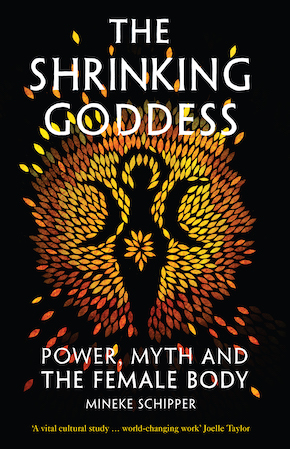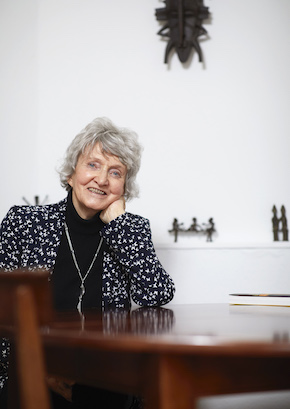A precarious house of stories
by Mineke Schipper
Over the past five decades I have researched proverbs, art, myths and other verbal genres that magnify the differences between men and women. These sources – many of which are thousands of years old – shed light on our conversations around gender today. For the most part, our myths are mainly concerned with justifying, or establishing, a patriarchal, hierarchical order. However, other genres, such as proverbs, art and folklore, struggle to address the precarious gender balance of power in society.
Comparing the cultural legacies of widely different people from around the globe, I discovered similar ideas and cultural messages – often with the same meaning and (mostly) similar form – expressed through different metaphors:
Women are like banana leaves: they never come to an end in the plantation.
(Ganda, Uganda)
Women are like shoes, they can always be replaced.
(Rajasthani, India)
Women are like buses: if one leaves, another one will come.
(Spanish, Venezuela)
Women are like frogs, for one diving into the water, four others turn up to the surface.
(Spanish, Peru)
Such similarities cannot be due only to globalisation, as they originate from times and cultures without demonstrable contact. How is this possible? Our common patterns as human beings have to do with the shape and functions of the human body and its basic needs, such as food, shelter, safety and procreation, and with emotions such as fear, longing, joy and sorrow, experienced by us all.
I have always told my students: if you look only for differences, you will find only differences. If you look for similarities, they are in front of you. Instead of looking for what we share, conversations around human identity are inclined to blow up our differences. Today’s global order goes back to a house of stories, built on mythical foundations, by influential storytellers, who established a strong belief in the differences between sexes.
Since the beginning of time, human beings have devised images of themselves and embedded them in stories, songs and other forms of artistic expression. The nature of how human beings present themselves through such images has varied according to the interests of those involved and the contexts in which they lived. One of the main tasks of my field is to study the similarities and differences of how humankind presents itself in oral and written traditions.
Humanity is divided by an ongoing history of exclusion, with devastating consequences. Nonetheless, small miracles happen.”
Looking into the worldwide harvest of cultural legacies helps us to put our local views into a wider picture. To make sense of a patriarchal structure, and the ways in which it is sustained, we need to understand its foundations. This book takes a wide-ranging look at our global house of stories and ideas around gendered body parts and the power they wield. Awareness is a modest first, crucial step towards questioning our established views of the self and the other.
Humanity is divided by an ongoing history of exclusion, with devastating consequences. Nonetheless, small miracles happen. In February 2004 I had a totally unexpected experience. After my book Never Marry a Woman with Big Feet came out, The Times invited me to write about the how and the why of this book. Titled ‘Beware of women with big feet’, the article went into my extensive travels and conversations with a large variety of people, first in Africa where I lived several years in DR Congo, later in other parts of the world. Following my travels, I spent years working on the collected material of more than 15,000 proverbs about women (and men), studying how proverbs have helped impose restrictions on women’s place and role in contemporary society.
Two weeks after this article appeared as the leading Times Weekend Review article, a huge, mysterious airmail package arrived for me on the doorstep of my Leiden University office. It contained a number of impressive books of Arabic proverbs and a letter from the generous Saudi sender, living in Riyadh. He had read my article and assured me in his letter that, had he been in Leiden, he would have loved to have had a long conversation. Instead, to express his appreciation for the article, he had sent me this gift. This encouraging gesture from the other side of the world convinced me that patient research may build cross-cultural bridges.
The power of myths
Myths deal with crucial issues that affect society. We are enmeshed in traditions passed down from generation to generation, which connect us more closely to our ancestors than we may realise. They lay the foundations for human existence. As long as people believe in their own stories, the established order depicted in their traditions persists.
In The Shrinking Goddess myths, proverbs, popular culture and past philosophical and medical perceptions tell a pregnant story that throws new light on the female body, with the help of illuminating pictures. Cultural traditions from around the world reveal a desperate need for control over ‘her’, leading to extraordinary beliefs and practices, from fanged wombs to the so-called island of menstruating men. Similar patterns make us ask to what extent the male wish for dominance over the female body has been successful.
The first part of the book goes back to the enormous impact of myths, even today. It shares a history of creation goddesses, and how they slowly and surely made way for male creators. Part II goes into the enlightening wealth of stories and comments on the mysteries of the female body, from the hospitable breasts praised as the ‘hills of paradise’ to fear of the hymen, and the awesome power of the womb’s life-giving capacity.
In the third and final part of the book we are confronted with the consequences of globally developed hierarchies in human history: the continuing violence of physical power inspired mainly by mental insecurity and fear; the ongoing demonstrable preference for sons over daughters in many societies; and the vulnerability of those declared subordinates who risk ending up in contempt of their own appearance, thanks to compelling commercials and other influential media. Finding out how today’s widely held views came into being, and what they tell us about society in the past and present, will help us in taking new roads into the future.
from The Shrinking Goddess (The Westbourne Press, £16.99)
—

Mineke Schipper is a cultural historian and writer. Her previous critically acclaimed works include Never Marry a Woman with Big Feet: Women in Proverbs from Around the World and Naked or Covered: A History of Dressing and Undressing Around the World. A former foreign secretary of Dutch PEN, and chair of Index on Censorship Nederland, she is Emeritus Professor of Intercultural Literary Studies at the University of Leiden, and has been a visiting professor in in Nigeria, Kenya, Zimbabwe, Burkina Faso and China. She lives in the Netherlands. The Shrinking Goddess is published by The Westbourne Press in hardback and eBook.
Read more
minekeschipper.nl
@MinekeSchipper
@saqibooks
Author photo by Christiaan Krouwels

